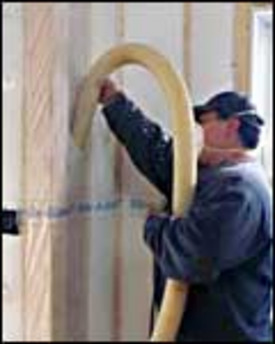An ideal insulation job is free of voids, provides a consistent level of thermal efficiency, and does not deteriorate over time. This degree of perfection has traditionally been hard to attain. Consumer complaints range from settling of the insulation over time due to compression and voids that give an inconsistent degree of thermal efficiency, to off-gassing of harmful chemicals, to difficulty of application in curved details or cathedral ceilings.
The Blow-In-Blanket System (BIBS) takes aim at all these complaints with a patented insulation delivery system that blows what is called "white" or completely unadulterated fiberglass into fabric-encased cavities to provide a consistent and highly insulative layer of protection anywhere in the home. This white fiberglass is clear glass that looks white as it refracts light. The white color is also a sign that it is dry and untreated.
Why It Works
Unlike traditional cellulose blown insulation, this product will not settle. The Blow-In-Blanket process can guarantee R-values of 15 in exterior walls and two-by-four cavities because it is blown in to a density of two pounds per cubic foot. Fiberglass batt insulation also provides R-values of 15 in two-by-four cavities, but it is difficult to fit in crevices, around doors, fixtures and outlets, so unwanted voids occur and that is where energy is lost. A blown-in installation guarantees a custom fit because the fiberglass seeks out and fills every void.
BIBS is a dry installation that requires no adhesive and is guaranteed against settling because the fiberglass fibers are packed in so firm that they cannot shift. "It won’t settle because of the density," says Steve Malon, a certified Blow-In-Blanket contractor and trainer for the Blow-In-Blanket Contractors Association (BIBCA). Certified installers are required by contract to verify the results on each job. "Part of the patent use is you have to test every job," Malon says. "You have to do a full-scale density test to guarantee results." To do this, contractors cut out one cubic foot of installed material and weigh it on a scale. It must weigh between 1.8 and 2.3 pounds in order to satisfy its claim to high and consistent R-values.
How It’s Done
The first step is to enclose the wall and ceiling cavities with a BIBS fabric that is stapled in place. This fabric creates an enclosure and holds the blown-in fiberglass in place. Unlike the netting that is used with other blown-in applications, the BIBS fabric is breathable but does not have the holes that allow insulation fibers to escape. In new construction, this fabric makes insulating all faces of the home possible, even in cathedral ceilings that do not have insulating attic space above them. Blow-in-blanket installations are also possible in retrofits, where there is no fabric to encase the cavity. In this case, contractors use a table to calculate the number of bags required to fill the cavities to the prescribed density.
Once the netting is secured, a slit or hole is cut in each cavity to fit the blower hose. The insulation contractor fills each cavity to a two-pound density, which is evident from a slight bulge in the netting wall. Installation is very quick with much less mess than traditional blown-in or sprayed-in insulation applications because woven fabric is used instead of netting, the cavity is enclosed, and adhesive need not be sprayed in along with the fiberglass to ensure against settling. With the Blow-In-Blanket system there is an expense up front that brings a payback in energy savings in just one to four years, depending on the region and local energy costs.
A BIBS installation has no chemical treatments, so it will not offgas or release harmful chemicals into the air like some treated cellulose products. It is completely inert and will not support moisture, fungal growth, or provide food for insects or animals. It is non-corrosive and will not contribute to the rusting or deterioration of pipes or studs. It is fire resistant and provides superior sound control.
Finding a Contractor
A true BIBS system can only be provided by a certified insulation contractor. These installers are trained by BIBCA and receive a license that must be renewed every two years. Trained and certified contractors are listed in the BIBCA directory, which can be accessed online. Companies and contractors vary when it comes to product for BIBS application, however. The two main providers of blow-in fiberglass for the BIBS installation are CertainTeed and Johns Manville. Each company offers a fiberglass that can be blown in with a nozzle that delivers a fine mist adhesive to guarantee against settling. While this is no longer necessary due to advances in the fabric and the insulation, some contractors still prefer the added measure of insurance. For some contractors and crews, this application is messy and slows the job because additional cleanup is necessary and drywall installers have to wait until it’s dry and clean.
Regardless of the insulation manufacturer selected, there is no doubt that a Blow-In-Blanket installation gives a custom fit each time. The ability to fully insulate around outlets, windows, arches, and openings increases thermal efficiency tremendously. The industry estimates energy savings of 30 to 50 percent with a BIBS installation. While the up front cost may be 40 to 60 percent more costly than a traditional batt installation and run about $400 to $500 more up front for a 1,500 square-foot house, Mike Hobson of Westchester Insulation estimates that customers will see a payback in just two to four years.
Credit: Renovate Your World




























